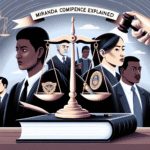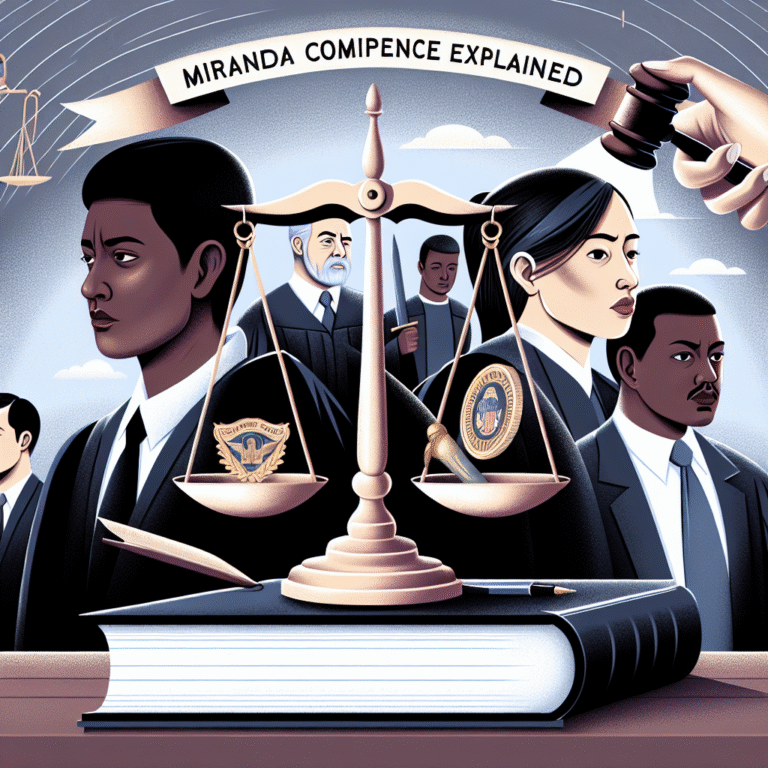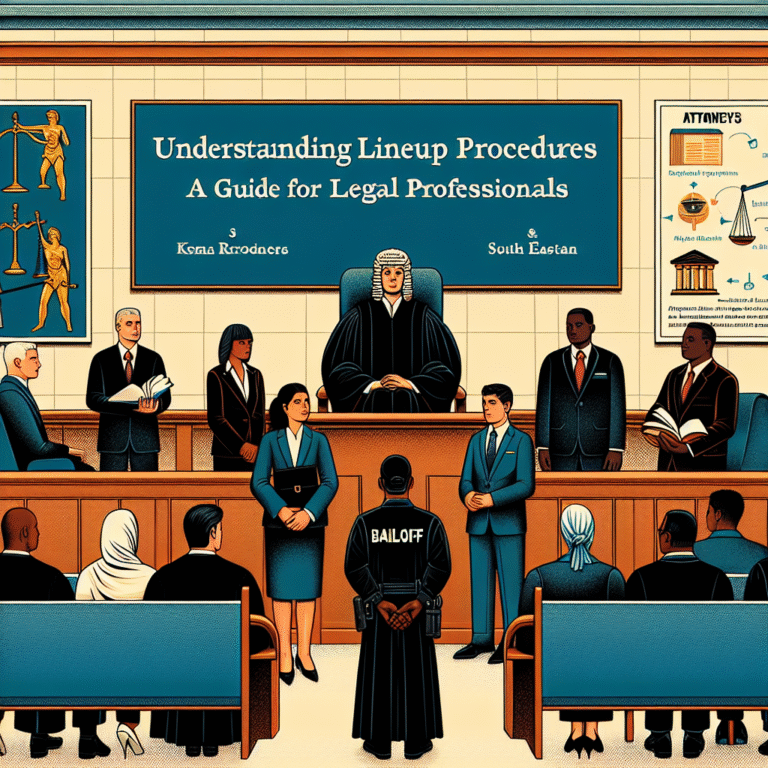
Introduction
In the realm of criminal justice, the term "Miranda rights" resonates deeply, sparking debates, studies, and countless courtroom dramas. This fundamental aspect of criminal proceedings—first established in 1966 by the U.S. Supreme Court in Miranda v. Arizona—ensures that individuals are aware of their rights before being subjected to custodial interrogation. Yet, what does it truly mean to assess Miranda competence?
Exploring Case Studies in Miranda Competence: Lessons Learned from the Courtroom offers invaluable insights into how these rights are invoked, understood, and sometimes violated. Through an analysis of real-world scenarios, we can uncover the intricacies of legal competence, deficiencies in understanding, and the implications of these factors in the courtroom.
The Significance of Miranda Rights
Before diving into case studies, it’s vital to grasp the significance of Miranda rights. They serve as a powerful protective measure against self-incrimination, ensuring due process is upheld. However, the effectiveness of these rights relies heavily on an individual’s understanding. This brings us to Miranda competence—the ability of a suspect to comprehend and waive their rights knowingly and voluntarily.
The Role of Miranda Competence in the Legal System
Miranda competence isn’t merely a legal benchmark. It’s a moral and ethical obligation. Courts are tasked with ensuring that defendants grasp their rights, and this responsibility has profound ramifications for both the accused and the justice system at large. Without sufficient understanding, confessions could lead to wrongful convictions or undermined legal processes. Our exploration of Case Studies in Miranda Competence: Lessons Learned from the Courtroom can illustrate these truths vividly.
Case Study Analysis
Case Study 1: Miranda v. Arizona (1966)
Overview: The landmark case that established the requirement for law enforcement to inform suspects of their rights.
Relevance: This case underscored the need for a clear understanding of Miranda rights. The defendant, Ernesto Miranda, was unaware of his right to remain silent and the consequence of waiving it. This foundational case represents the starting point for evaluating how Miranda competence is determined in subsequent cases.
Analysis: Miranda v. Arizona serves as a reminder that clarity in communication is essential. The court’s ruling has evolved the standard for understanding competency—raising the bar for professionals trained in interrogation techniques.
| Key Point | Outcome |
|---|---|
| Rights Notification | Required by police before questioning |
| Competency Standard | Must be understood by the suspect |
| Impact on Future Cases | Established precedent for Miranda warnings |
Case Study 2: Colorado v. Connelly (1986)
Overview: A case that questioned the mental state of a suspect during confession.
Relevance: In this scenario, the defendant, John Connelly, had a history of mental illness. His mental state raised significant concern about his competence to understand his rights and the consequences of waiving them.
Analysis: This case pushes the boundaries of Miranda competence. It highlighted that mental health plays a crucial role in a suspect’s ability to grasp their rights. The Supreme Court ruled that mental illness could negate a confession’s voluntariness but did not inherently undermine the applicability of Miranda rights, admitting complexities that remain prevalent in courtrooms today.
| Key Point | Outcome |
|---|---|
| Mental Health Consideration | Highlighted the impact on competency |
| Confession Validity | Ruled admissible despite mental illness |
| Long-term Implications | Scrutiny of interrogation methods |
Case Study 3: Miranda v. Arizona Revisited: The Texas Case of 2010
Overview: A more recent case involved a defendant who claimed insufficient comprehension during interrogation due to a language barrier.
Relevance: This case emphasizes the critical role of understanding non-verbal cues and language proficiency for Miranda competence. The arresting officers failed to ensure that the rights were effectively communicated to a Spanish-speaking suspect.
Analysis: The court ruled that the failure to provide appropriate translation services constituted a violation of Miranda rights, reinforcing that language barriers significantly affect competency. This case draws attention to the need for law enforcement to accommodate diverse populations and highlights ongoing adjustments in interpreting Miranda competence.
| Key Point | Outcome |
|---|---|
| Language Barriers | Must ensure understanding in all languages |
| Necessity for Translators | Important for fair legal proceedings |
| Broader Implications | Raises issues of accessibility in justice |
The Importance of Training and Protocols
Bridging Gaps in Understanding
The Case Studies in Miranda Competence: Lessons Learned from the Courtroom emphasize that effective training for law enforcement personnel is vital for ensuring that suspects fully comprehend their rights. Without structured procedures, the risks of unknowing waivers increase—jeopardizing the integrity of the justice system.
- Enhanced Training Modules: Developing comprehensive training programs that focus on communication, cultural sensitivity, and psychological assessment can equip officers to handle diverse scenarios adeptly.
Legal Guardianship and Representation
Another crucial aspect derived from case studies is the necessity for legal representation. Suspects, especially those with mental impairments or language barriers, benefit greatly from having a legal guardian or attorney present during interrogation. This is not merely a protective measure but a means to ensure compliance with constitutional mandates.
| Training Component | Suggested Action |
|---|---|
| Cultural Sensitivity | Systems of training on diverse groups |
| Psychological Assessment | Protocols for understanding mental health |
| Right to Counsel | Promote representation during interrogations |
Conclusion
The exploration of Case Studies in Miranda Competence: Lessons Learned from the Courtroom not only showcases the intricate legal framework surrounding Miranda rights but also underscores their vulnerability within the justice system. As we’ve seen through various case studies, the complexity of mental health, language barriers, and the necessity of competent legal representation all converge to shape how and when justice is served.
To truly honor the spirit of Miranda rights, stakeholders must engage in continued education, advocacy for policy reforms, and the promotion of ethical interrogation practices. By doing so, we can help ensure that justice is not only served but is equitable and representative of our society’s diverse fabric.
FAQs
1. What are Miranda rights?
Miranda rights inform individuals of their right to remain silent and to have an attorney present during questioning by law enforcement.
2. How is Miranda competence assessed in court?
Miranda competence is assessed based on an individual’s capacity to understand their rights, often involving evaluations of mental state, age, and language proficiency.
3. What happens if Miranda rights are violated?
If a suspect’s Miranda rights are violated, any confession or evidence obtained may be deemed inadmissible in court.
4. Are there specific cases where Miranda rights were not upheld?
Yes, several cases—including those involving language barriers or mental health issues—illustrate instances where rights were insufficiently communicated or understood.
5. How can law enforcement improve understanding of Miranda rights?
Enhanced training in communication, cultural sensitivity, and psychological assessment, along with ensuring legal representation during interrogations, can improve the effectiveness of Miranda rights.
By integrating these lessons learned from the cases examined, we can promote a justice system that truly respects and protects individual rights.

















